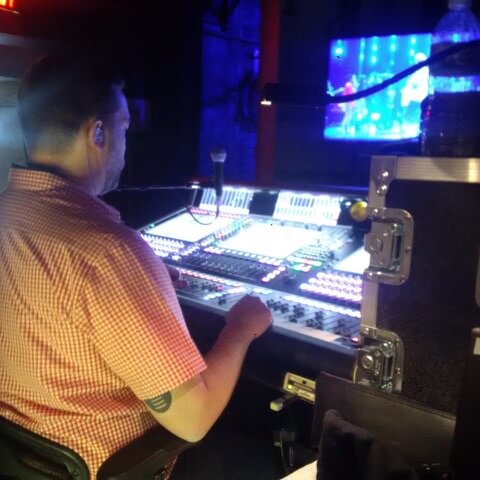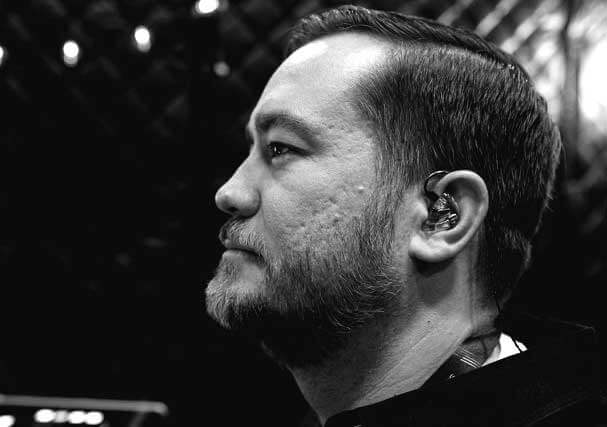If your band is going to play a late-night TV show, here’s a step-by-step guide on how to seize your moment. Don’t forget the IEMs.
Being prepared beforehand will eliminate a multitude of issues that will make your big day on camera successful. Stepping into the focus brackets of the camera lens can induce a fear that feels similar to staring down the eyes of an NFL lineman. Those monoscopic wide-angle HD lenses show off more than just those extra wrinkles creeping in. So, let’s help you relax and feel confident, knowing ahead of time what to expect.
Your band should spend time in a rehearsal space working on the song and getting your IEM mixes locked. As on any modern stage show, whether arena or theaters, in ear monitors are a tool that provides a controlled environment by blocking out the rest of the sound around you. Your in-ears will also deliver click track and program cues.
LOCK YOUR RIGS IN
Tidy up your pedal boards and looms. Fix those loose jacks. Decide on wardrobe and rehearse with it. This will reveal if those chain mail vests will get snagged or even block radio frequencies from getting to your ear pack.
Make sure to have backups of crucial pieces of gear. At the very minimum have a dual redundant playback rig with eight or more dedicated outputs. The 1/8” out on your laptop with track on the left mono and click on the right will not cut it for broadcast TV.
If your performance includes moves that are timed to the track, create a click track and slate track — voice commands pre-recorded and dropped on a separate track for cuing song sections, dance moves, etc. — output from the playback rig available to everyone who will need it: dancers, special effects, the light board operator.
If a band member typically runs the tracks rig, work with a professional playback operator for rehearsals and the taping/performance. This will also help with any last-minute arrangement changes. They will know the best ways to create good intros, endings, and transitions.
One to two days of rehearsal in the days leading up to the taping is necessary. Setup in the layout that you’ll be playing in. The idea is to walk into the studio with as tight of a performance as you can get.
Repeat after me. Once everything is dialed, resist all urges to introduce anything new — no matter how seemingly insignificant. That means no new pedals, cymbals, outfits, wireless, performers. Nothing.
The more self-contained and polished that your performance can be, the better it is to navigate all of the curve balls that will come up. On the day of the show, you’ll collaborate with the director and creative team but don’t veer too far from the product you perfected at the rehearsal studio.
https://www.youtube.com/watch?v=ujusAEHq4YY
DAY OF: GAIN THE TRUST OF THE HOUSE CREW
On most late-night shows, the house crew will work with five bands a week. You’re just one act in a five-act show and your show is just one of the many shows they will see that season. In the first year of Late Night with Jimmy Fallon, there were 172 episodes total and only 37 of those episodes didn’t have musical acts.
The reason to have a good rapport with the house crew is the TV production world has a set structure as to how the daily schedule operates. The same dance happens on the studio floor every day — whether it’s your band or Beck.
The day at the studio revolves around a production schedule and that schedule will include a slot for your band to setup and sound check. This is followed by a time for the director to take a look and convey any blocking, staging or lighting changes to the music stage manager. All of these mechanisms exist around the musical performance so they can fit your 3-4 minutes into the structure of an already well-oiled TV production. Remember that you are a guest on their show.
THE CAMERA BLOCK RUN-THROUGH
After your band is setup and the blocking is locked, the lighting director will adjust the lights to further set the scene for your performance. All of your road techs get to interface with the TV crew to make these hand-offs successful. As production elements, band risers and any floor lights get locked in, and the stagehands will start marking the floor so they can restore your gear to the exact spots during the change over from talk show to music performance.
The culmination of this time is a camera block run-through where hopefully you play the song and do any moves exactly the way you will for the taping or live performance that night. The part of the show that your band will play in is rehearsed in its entirety with the music stage manger as your guide. They will sit or stand in the appointed spot where the host will be to give the intro for your performance. They will then wait for the cue from the director via headset to give the standby to all crew and band.
At this point, you should be at your starting marks and ready to spring into action. The director cues the intro, and the stage manager will read the intro copy and “toss” to the performance area. Then the magic starts.
The cameras will be moving in and out, up and down to get every angle of your performance. Any moving set pieces will come and go as they are cued. Everything will happen as it will happen that night.
Following your song, the stage manager will enter and give an outro just as the host will during the taping. If all departments call the run through good and no tweaks are needed, then the musical act will be cleared from the set and the crew will go about methodically dismantling the music performance area so the next element of the show can be rehearsed.
SHOW TIME
While you’re backstage getting your “last looks” from makeup, the stage crew is setting the risers and moving all the elements back to the floor exactly where they were from rehearsal some hours ago.
You emerge from a small back room right out into the middle of what seems like the market of a bustling metropolis. Stay focused, young Jedi. Acknowledge the host with a slight wave and smile, but then get right to work. Start doing checks as quickly as possible; tune your instrument, start checking in with your band mates, run a vocal lick or two. Most importantly, turn on your IEM pack and get your molds comfortably situated. It will be a bit cacophonous, but as things settle in and everyone is making their systems work, start to form a decorum.
Get everyone to focus. The house band will be playing through the break. You have eye contact and the world inside your IEMs to find that place of comfort. Look at your band mates, and when it feels like the machine is ready to fire, do a false start on the tracks. Make sure you can hear the intro and count off. I usually run clicks and counts on a TV show just a bit louder than normal in the IEM mix while being mindful of hearing safety.

DON’T FORGET: CHECK YOUR LEVELS
What’s not present during camera block is a studio audience cheering. This can throw off the intro of the song and your faces will show it up until the first chorus. And there is nothing worse for a monitor engineer than the obvious “pack reach” during an on-air performance. I find it ok to actually play along with the first few bars during the track false start exercise. You’ll know immediately if your IEM pack is at the right level for this situation.
Besides all of the musical things that are in your IEM mix, there will be an additional channel mixed in. This is the “program” channel. Most TV monitor mixers will add in this channel in order for the performers to follow along with what’s happening in the show right before and right after the performance segment. There is nothing better than hearing the intro for your band read by the host in your IEMs. “And here they are….”
This feed is generated from the A1 mixer. The A1 mixer combines all inputs except the individual musical inputs on their console. That console is the final stop before it is married with the video program and sent to air. Further down the line is the TV music mixer. This mixer is in control of all the musical inputs on the show that day. They create a typical mix that would appear on a commercial musical release. This mix is sent to the A1’s console for them to mix in with the rest of the audio program material. Really this is all about division of labor as one mixer wouldn’t be able to tend to the workload of all of those inputs.
THAT’S A WRAP
Following your performance, the lights will come up, the host will usually cross to the performance area and throw to a commercial. The audience will applaud and the program feed on the in-studio TV monitors will fade to black. At this point, if it’s a taped performance, the stage manager will cross to you and ask if you’re good with the performance. There is sometimes, but not always, a chance to retake the song and the corrected take can be stitched into the show between the intro and the outro given by the host. The time to decide whether or not to rerun the segment is fleeting.
This brings me to another important organizational element. There needs to be an advocate for the band in the Music Mix booth. This is where all decisions of how you will be presented to the public are made. If it’s good in that booth, then it’s the best it can be going to air. Have someone who was at the rehearsals and knows your vision in the booth. The stage manager is waiting for an okay from you on the floor and an okay from the Music Mixer before moving on to the next piece of the show. Some technical issues can be fixed by flying in elements from rehearsal takes, especially if a click track is used, so make sure to choose your battles carefully.
At the end of the day, have fun. Having the opportunity to perform on a TV show for the first time is very powerful. It cements a moment in time for your band. I’ve seen some chill-inducing performances. They will live on for a very long time.
ABOUT THE AUTHOR
Paul Klimson is a monitor engineer who has worked for Drake, The Roots and Justin Timberlake. Klimson brings twenty highly-credited years of technical experience to the details of audio, staging, video, and lighting arrangement in the areas of television broadcasts, arena performances, international music festivals, and top-tier special events production. He designs, creates, and implements the technical foundation upon which the most resonating musical performances of the day exist.

